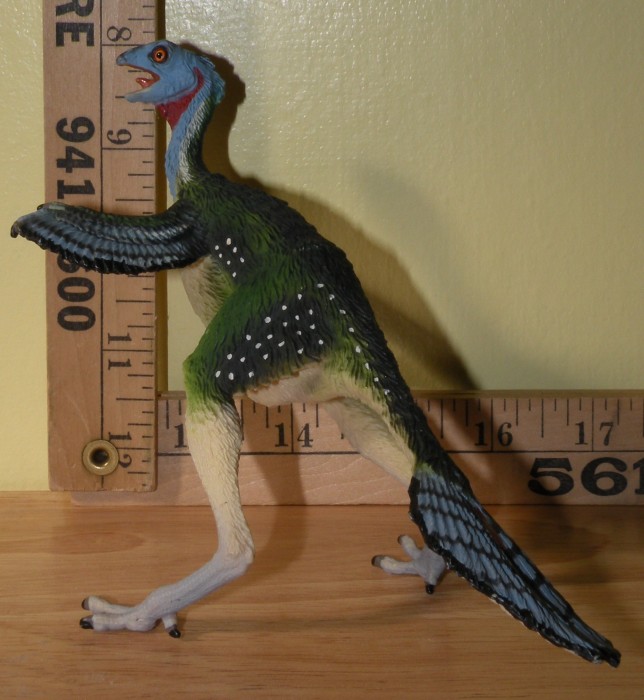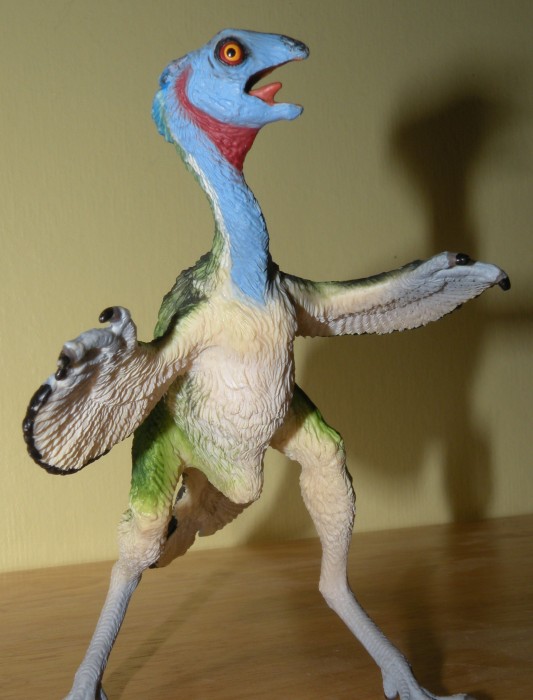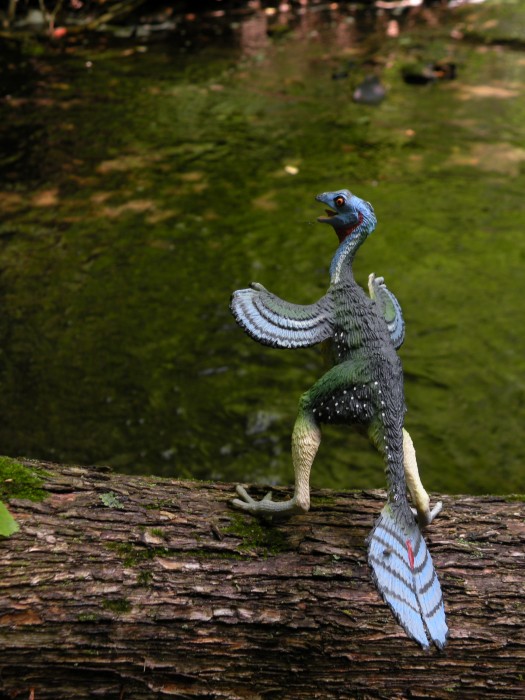It’s a bird…it’s a dinosaur…it’s possibly both. It’s the Carnegie Caudipteryx! Although reviewed briefly in 2007 it’s time this stunning oviraptorosaur got the more in depth treatment it deserves. Released in 2006 with several other feathered representations of China’s Yikian formation, this is Carnegie’s take on the small theropod that remains one of the best feathered dinosaur models available. The true nature of oviraptorosaurs is still under question. Debate continues as to whether these animals were actually secondarily flightless birds or their own branch in the maniraptora family tree. Regardless, the actual animal described in 1998 represents just how blurry the line between dinosaurs and birds is, partly because there is no line. It is just not possible to distinguish birds from dinosaurs.
The Carnegie Caudipteryx is a stunning example of what Carnegie is capable of. It is exquisitely detailed and a fairly accurate representation of this feathered dragon. With such attention to detail on this and most of their other feathered dinosaurs one can only hope Carnegie will someday do a properly feathered dromaeosaur like Velociraptor or Deinonychus.
This 1:5 scale model stands 5” tall and measures about 7” from nose to tail. Like the majority of Carnegie figures it stands in the tripod stance with the tips of its beautiful tail feathers touching the ground. Some models like mine can be coaxed into standing on its feet only but it isn’t very stable. Although it is in the tripod stance the figure looks quite dynamic. Its arms are out to the side and it has an alert if not concerned expression on its face. Mouth agape and wild eyed it has a look of fierce desperation. Perhaps it is warning the flock of danger? Trying to intimidate a rival or enemy? Protecting its eggs? Whatever this Caudipteryx is doing is up to your interpretation. If I were to hazard a guess, however, I would assume this figure represents the male of the species. It has all the colors and patterns of an extant galliform; pheasants, chickens, peafowl, etc. The back is a mix of dark greens and black patterns speckled with white spots at the base of the tail, the sides and parts of the legs. The wings are mostly blue with black bars. The head is also blue with a red throat patch. A red mark is also present on the tail. The underside is a creamy off white color. The eyes are yellow ringed in red with black pupils. Overall it is quite eye catching and stands out in any collection. The legs are long and appropriately bird-like with fine scales sculpted throughout. The feathery coat is well detailed and this model is indeed fully feathered, no half naked dinosaur here.
Where accuracy is concerned there is little to complain about. All the proportions seem correct and even the feathers and in particular the tail fan resembles the actual fossils of this animal. The tail is appropriately short as well. Caudipteryx had a fairly short tail that was not too dissimilar to those in extant birds. Unfortunately there are a couple nit picks worth pointing out. The feathers on the arms extend down the last finger where they should go down the middle. This is a common mistake with feathered dinosaur models but at least they extend down a figure instead of stop where the fingers start, a more distressing mistake made too often. Also it would seem Carnegie has made this model a little too much like modern birds as despite the lack of them here the real life Caudipterx had teeth within its beak. The teeth would have been very small though and so their absence in this model is nothing worth getting too upset about.
Lately, Carnegie has resorted to releasing more traditional dinosaurs. It has been six years since they released the Caudipteryx and its feathered contemporaries. Hopefully they will remedy that soon as a plethora of other feathered dinosaurs have been discovered since then, some for which we now know their coloration. Get on it Carnegie! Until then we still have the older models to enjoy. If you don’t already have the Caudipteryx now is the time to get it. It is still in production and can be found in many places Carnegie models are sold including Amazon.com and eBay.com.
// \x3C/script>’ );
// ]]>
Disclaimer: links to Ebay and Amazon on the DinoToyBlog are affiliate links, so we make a small commission if you use them. Thanks for supporting us!







[…] on the arms and an impressive tail fan, seems to be based on the oviraptorosaur Caudipteryx (a Carnegie stablemate) while the colouration is reminiscent of the work of paleoartist Luis Rey. Overall, this […]
[…] paradoxus lived in China in the Early Cretaceous, as did Caudipteryx and Beipiaosaurus (although perhaps not at exactly the same time), both of which have also […]
A great replica with wonderful details and all…But,who ever knows why,its face reminds me of Lenny (from “The Simpsons”) XD
Every time i look at this model, I think of it screching out the Sound of a Peacock.
When this was announced, I was pretty blase, since I consider small theropods to be usually quite boring. However, this is a gorgeous sculpt with wonderful colors.
Very nice review. The last photo is gorgeous!
The figure has tertial feathers (which I don’t think Caudipteryx ought to have had, but I could easily be wrong), but apparently lacks primaries. Minor issues, however. It’s still lovely! My only real complaint is that it and its feathered brethren from Carnegie appear gawky and uncomfortable; and I don’t mean its expression.
Yeah, I’m not very up to speed on the different feather variations. Something I need to work on but thanks for the correction. As for the uncomfortable and gawky appearance I’m not seeing it with this one but I can see that with the Microraptor.